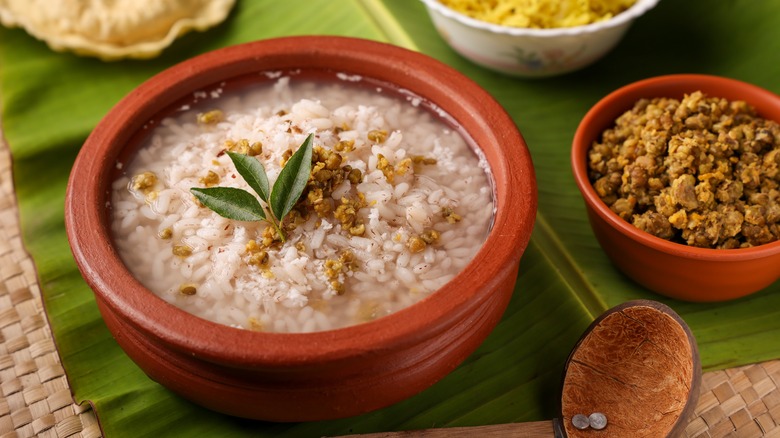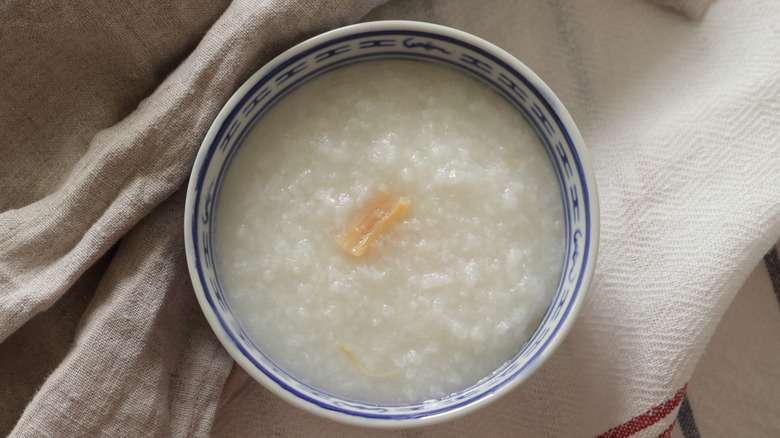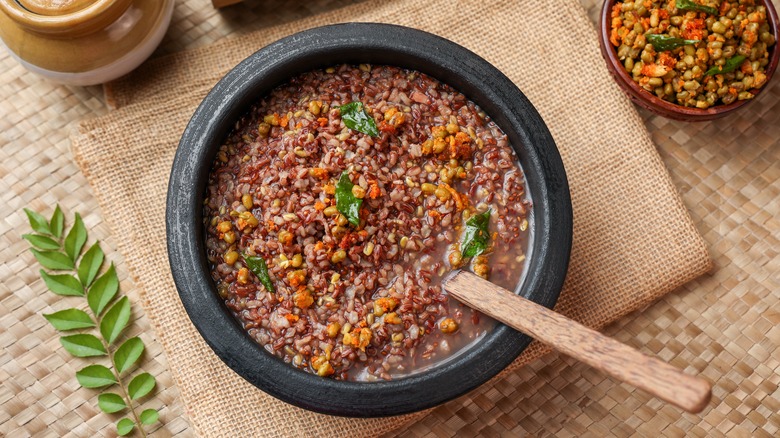What Is Kanji And What Does It Taste Like?
For those unfamiliar, Kanji is a one-pot rice porridge that hails from Sri Lanka and has been consumed by the indigenous Tamil people for centuries. Though commonly a nourishing breakfast dish, it can be eaten for breakfast, lunch, or dinner; and sometimes, as it was for many Tamils during the Sri Lankan Civil War, it was the only food consumed most days.
While Sri Lankan cuisine is known for being full of spices and packed with flavor, during the hardship of the war, a modest version of the dish was made simply by boiling rice with water and a pinch of salt. In contrast to its wartime simplicity, kanji can also be a richer, more indulgent dish containing coconut milk and garnished with onions and green chilies, making it a more hearty, comforting meal. It's actually a pretty versatile dish, with versions existing in South India and elsewhere in Southeast Asia, which are served alongside pappadam, pickles, and even whole curry dishes. Ultimately, the dish itself is pretty bland and it's up to the cook to spice it up with additional ingredients, whether they be sweet or savory.
The distinction between Tamil kanji, a rice porridge, and the North Indian beverage also called kanji, a fermented probiotic drink, is also crucial. While they share a name, they are entirely different in preparation, taste, and cultural significance.
The cultural significance of kanji
Kanji became a powerful emblem of the suffering and endurance of the Tamil people during the Sri Lankan civil war from 1983 to 2009. In these grim times, especially during the final stages like the Mullivaikkal offensive and massacre in 2009, kanji wasn't just a food, it was a lifeline. The stripped-back, three-ingredient version of kanji is now referred to as 'Mullivaikkal kanji' to acknowledge its link to this tragedy. For many in the war-stricken zones, kanji served in a coconut shell was the day's sole nourishment and became a defiant symbol of survival under siege.
The cultural resonance of kanji within the Tamil community is potent, particularly due to its function as basic sustenance for many Tamil people during the Sri Lankan Civil War. In the years following the war, the act of cooking and serving kanji, especially on Maaveerar Naal (literally "Great Heroes Day" in Tamil) on November 27th, has taken on new significance and is a ritual of remembrance. Kanji is served on this day to honor the Tamils, both soldiers and civilians, who suffered or lost their lives during the war. This simple act of preparing and sharing kanji has evolved from being an indigenous staple to an act of survival to a profound gesture of collective memory and cultural identity for the Tamil people.
Kanji and its legacy today
Kanji's influence extends far beyond its ancient Tamil origins, however. On the one hand, it has influenced or bears comparison to not just congee, a Chinese rice porridge, but a whole host of other Southeast Asian rice dishes. Vietnamese chao bo, Filipino lugao, the Japanese breakfast porridge okayu, and khao tom gung rice soup in Thailand all bear similarities to kanji.
At the same time, kanji remains a defiant and personal symbol of Tamil identity and the people's collective history, particularly for the Tamil diaspora around the world. For example, in May of 2022, the British Tamil Alliance handed out kanji in London to mark Tamil Genocide Day. The dish, whether in its simplest, wartime form or more luxurious versions with coconut milk and other ingredients, serves as a nutritional comfort to Tamil people who feel a close connection with its significance. The meaning behind the dish gives the humble kanji more complexity than the simplicity of its ingredients could provide on their own.
Aside from the powerful cultural significance of kanji to the Tamil people, it is also noteworthy for potentially being the origin dish for the previously mentioned Chinese savory rice porridge congee, famed for turning leftover rice into a comforting delicacy in its own right. However, while the word 'congee' is itself derived from the Tamil word 'kanji', the exact timelines of these two related dishes are unclear, with both dating back thousands of years. The bottom line though, is that although kanji can be simple in preparation and flavor, its importance to its people makes it a legacy dish.


